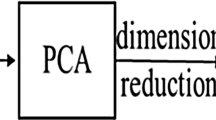Abstract
Clock bias is a vital element in clock calibration system. Aiming at effectively eliminating noises contained in clock bias and improving accuracy of time synchronization, we propose an adaptive algorithm. In this adaptive algorithm, ensemble empirical mode decomposition (EEMD) is employed to decompose original data to different intrinsic mode functions (IMFs). For accurately abandoning IMFs which contain plentiful noises, principal components analysis (PCA) is proposed. Eigenvalues of all IMFs are ascertained on the bias of PCA. Then, bias between adjacent eigenvalues is used to evaluate level of noises contained in each IMF. Finally, residual IMFs are used to reconstruct the signal. Clean signal with adding noises is used to evaluate this improved algorithm. Consequence indicates that this improved algorithm is effective. We design a clock calibration experiment, where the time signal is transferred through a wireless channel. The adaptive algorithm is used to dispose bias, which is acquired in clock calibration experiment. Consequence also demonstrates that this algorithm can effectively and adaptively eliminate noises contained in actual data.











Similar content being viewed by others
References
Xiang, W., Xu, B., Mou, W., & Wang, F. (2013). A clock error calibration algorithm based on phase lock loop in GNSS time synchronization receiver. Journal of National University of Defense Technology, 35(2), 115–119.
Wan, H., Diouris, J. F., & Andrieux, G. (2012). Time synchronization for cooperative communication in wireless sensor networks. Wireless Personal Communications, 35(4), 977–993.
Maitra, S., & Newman, K. (2010). Time synchronization protocol with minimum message communication for high latency networks. Wireless Personal Communications, 55(4), 525–537.
Arceo-Miquel, L., Shmaliy, Y. S., & Ibarra-Manzano, O. (2009). Optimal synchronization of local clocks by GPS 1PPS signals using predictive FIR filters. IEEE Transactions on Instrumentation and Measurement, 58(6), 1833–1840.
Dinc, E., & Akan, O. B. (2015). A nonuniform spatial rain attenuation model for troposcatter communication links. IEEE Wireless Communications Letters, 4(4), 441–444.
Huang, W., & Defraigne, P. (2016). BeiDou time transfer with the standard CGGTTS. IEEE Transactions on Ultrasonics, Ferrolectrics, and Frequency Control, 63(7), 1005–1012.
Shmaliy, Y. S., Manzano, O. I., Arceo-Miquel, L., & Munoz-Diaz, J. (2008). A thinning algorithm for GPS-based unbiased FIR estimation of a clock TIE model. Measurement, 41(5), 538–550.
Zhao, S., Shmaliy, Y. S., & Liu, F. (2016). Fast Kalman-like optimal unbiased FIR filtering with applications. IEEE Transactions on Signal Processing, 64(9), 2284–2297.
Lin, S. G. (2015). Assisted adaptive extended Kalman filter for low-cost single-frequency GPS/SBAS kinematic positioning. GPS Solutions, 19(2), 215–223.
Lei, Y., He, Z., & Zi, Y. (2011). EEMD method and WNN for fault diagnosis of locomotive roller bearings. Expert Systems with Applications, 38(6), 7334–7341.
Jia, R. S., Zhao, T. B., Sun, H. M., & Yan, X. H. (2015). Micro-seismic signal denoising method based on empirical mode decomposition and independent component analysis. Chinese Journal of Geophysics, 58(3), 1013–1023.
Jiang, H., Li, C., & Li, H. (2013). An improved EEMD with multiwavelet packet for rotating machinery multi-fault diagnosis. Mechanical Systems and Signal Processing, 36(2), 225–239.
Shi, X., Zhou, F., Tao, M., & Zhang, Z. (2016). Human movements separation based on principle component analysis. IEEE Sensors Journal, 16(7), 2017–2027.
Shokri, S., Sadeghi, M. T., Marvast, M. A., & Narasimhan, S. (2015). Soft sensor design for hydrodesulfurization process using support vector regression based on WT and PCA. Journal of Central South University, 22(2), 511–521.
Pyatykh, S., Hesser, J., & Zheng, L. (2013). Image noise level estimation by principal component analysis. IEEE Transactions on Image Processing, 22(2), 687–699.
Acknowledgements
This work was supported by the National Natural Science Fund of China under Grant No. 61671468.
Author information
Authors and Affiliations
Corresponding author
Additional information
Publisher's Note
Springer Nature remains neutral with regard to jurisdictional claims in published maps and institutional affiliations.
Rights and permissions
About this article
Cite this article
Liu, Z., Liu, X. & Chen, X. Adaptive Filtering Algorithm in Clock Calibration System. Wireless Pers Commun 101, 1295–1305 (2018). https://doi.org/10.1007/s11277-018-5763-9
Published:
Issue Date:
DOI: https://doi.org/10.1007/s11277-018-5763-9




